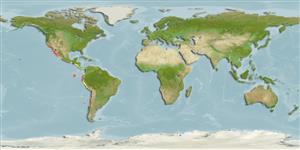Elasmobranchii (tubarões e raias) (sharks and rays) >
Carcharhiniformes (Ground sharks) >
Scyliorhinidae (Cat sharks) > Scyliorhininae
Etymology: Cephaloscyllium: cephalus, from kephale (Gr.), head, referring to its very broad and depressed head; skylion, Greek for dogfish or small shark. (See ETYFish); ventriosum: venter (L.), belly; -osus, Latin suffix connoting fullness, referring to its inflatable stomach. (See ETYFish).
More on author: Garman.
Environment: milieu / climate zone / depth range / distribution range
Ecologia
marinhas demersal; intervalo de profundidade 5 - 457 m (Ref. 96339), usually 5 - 37 m (Ref. 244). Subtropical; 40°N - 37°S, 126°W - 71°W (Ref. 55293)
Eastern Pacific: central California, USA to the Gulf of California and southern Mexico; central Chile.
Tamanho / Peso / Idade
Maturity: Lm ? range ? - ? cm
Max length : 110 cm TL macho/indeterminado; (Ref. 96339)
Found on the continental shelves and upper slopes from inshore to deeper waters. Prefers rocky, algal-covered areas of kelp beds. Nocturnal. Feeds on bony fishes, alive and dead, and probably crustaceans. Can inflate its stomach with water or air. Oviparous. Can live in tanks for several years and females can lay eggs in captivity. Occurs in aggregations while resting, sometimes piled one on top of the other. Sometimes caught by sport divers but not used.
Ciclo de vida ou comportamento de acasalamento
Maturities | Reprodução | Spawnings | Egg(s) | Fecundities | Larvas
Oviparous, paired eggs are laid. Embryos feed solely on yolk (Ref. 50449).
Compagno, L.J.V., 1984. FAO Species Catalogue. Vol. 4. Sharks of the world. An annotated and illustrated catalogue of shark species known to date. Part 2 - Carcharhiniformes. FAO Fish. Synop. 125(4/2):251-655. Rome: FAO. (Ref. 244)
Status na Lista Vermelha da UICN (Ref. 130435)
Ameaça para os humanos
Harmless
Uso pelos humanos
Pescarias: sem interesse; peixe esportivo: sim; Aquário: Aquários públicos
Ferramentas
Relatórios especiais
Baixar XML
Fontes da internet
Estimates based on models
Preferred temperature (Ref.
123201): 14.8 - 28.1, mean 22.3 °C (based on 90 cells).
Índice de diversidade filogenética (Ref.
82804): PD
50 = 0.5000 [Uniqueness, from 0.5 = low to 2.0 = high].
Bayesian length-weight: a=0.00263 (0.00139 - 0.00497), b=3.21 (3.04 - 3.38), in cm total length, based on LWR estimates for this (Sub)family-body shape (Ref.
93245).
Nível Trófico (Ref.
69278): 3.9 ±0.61 se; based on food items.
Resiliência (Ref.
120179): Baixo, tempo mínimo de duplicação da população 4,5 - 14 anos (Fec assumed to be <100).
Fishing Vulnerability (Ref.
59153): High to very high vulnerability (66 of 100).
